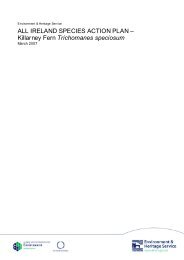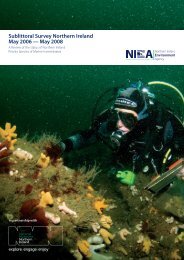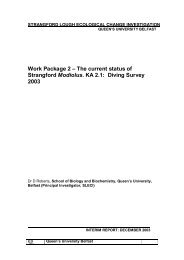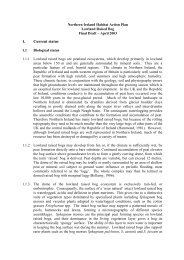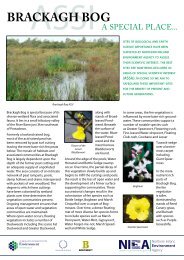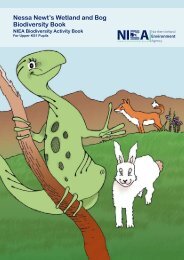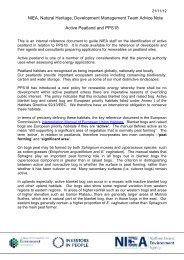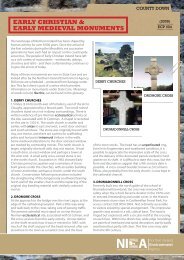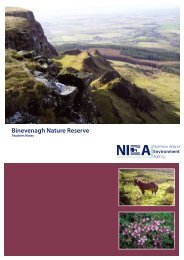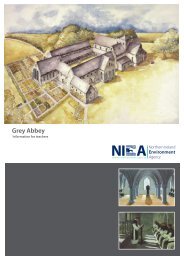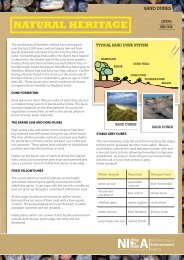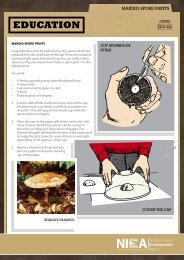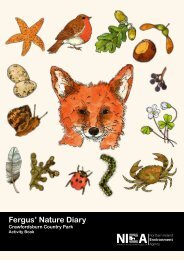Let's Explore Life in Early Times (.PDF 3.06
Let's Explore Life in Early Times (.PDF 3.06
Let's Explore Life in Early Times (.PDF 3.06
You also want an ePaper? Increase the reach of your titles
YUMPU automatically turns print PDFs into web optimized ePapers that Google loves.
The World Around Us<br />
<strong>Life</strong> <strong>in</strong> <strong>Early</strong> <strong>Times</strong><br />
Lets <strong>Explore</strong> <strong>Life</strong> <strong>in</strong> <strong>Early</strong> <strong>Times</strong><br />
<strong>Life</strong> <strong>in</strong> <strong>Early</strong> <strong>Times</strong><br />
The World Around Us<br />
<strong>Let's</strong> explore <strong>Life</strong> <strong>in</strong> <strong>Early</strong> <strong>Times</strong>
<strong>Life</strong> <strong>in</strong> <strong>Early</strong> <strong>Times</strong><br />
www.ni-environment.gov.uk
www.ni-environment.gov.uk <strong>Life</strong> <strong>in</strong> <strong>Early</strong> <strong>Times</strong><br />
<strong>Life</strong> <strong>in</strong> <strong>Early</strong> <strong>Times</strong><br />
Contents<br />
Introduction Page 1<br />
Ireland before People Page 3<br />
People come to Ireland Page 5<br />
<strong>Life</strong> <strong>in</strong> a Mesolithic Settlement Page 7<br />
The New Stone Age Page 9<br />
<strong>Life</strong> <strong>in</strong> a Neolithic Settlement Page 11<br />
Neolithic Farm<strong>in</strong>g Page 13<br />
The Bronze Age Page 15<br />
Sites to Visit Page 17<br />
Glossary Page 19<br />
Time L<strong>in</strong>e Page 20
<strong>Life</strong> <strong>in</strong> <strong>Early</strong> <strong>Times</strong><br />
<strong>Life</strong> <strong>in</strong> <strong>Early</strong> <strong>Times</strong><br />
Introduction<br />
In this booklet you will travel through time to f<strong>in</strong>d out how people<br />
<strong>in</strong> Ireland lived long ago. You will beg<strong>in</strong> <strong>in</strong> a time when there were<br />
no people <strong>in</strong> Ireland and see how our landscape has changed over<br />
9000 years. You will meet the first settlers, who arrived around 7000<br />
BC and discover how new ideas and <strong>in</strong>ventions changed how people<br />
lived and worked. You will also discover places to visit where you can<br />
learn more about these ancient peoples.<br />
The mean<strong>in</strong>gs of words <strong>in</strong><br />
bold, like this, can be found<br />
<strong>in</strong> the glossary at the back<br />
of the booklet.<br />
2. Drumsk<strong>in</strong>ney Stone Circle, Co. Fermanagh.<br />
page 1<br />
www.ni-environment.gov.uk<br />
1. The Giant’s R<strong>in</strong>g, Belfast.
www.ni-environment.gov.uk <strong>Life</strong> <strong>in</strong> <strong>Early</strong> <strong>Times</strong><br />
page 2
<strong>Life</strong> <strong>in</strong> <strong>Early</strong> <strong>Times</strong><br />
<strong>Life</strong> <strong>in</strong> <strong>Early</strong> <strong>Times</strong><br />
Ireland before People<br />
20,000 years ago Ireland was a very cold place. Most<br />
of the country was covered <strong>in</strong> snow and ice. This<br />
was the Ice Age. It was much too cold for people<br />
to survive <strong>in</strong> Ireland. There were no plants to eat or<br />
animals to hunt.<br />
Around 17,000 years ago temperatures began to rise.<br />
The great ice sheets that had covered Ireland slowly<br />
melted and moved north. They left beh<strong>in</strong>d a bare<br />
landscape with no trees or plants. Sea levels were<br />
much lower than today, so Ireland was still jo<strong>in</strong>ed to<br />
Brita<strong>in</strong> by land. Plants soon spread across from Brita<strong>in</strong><br />
and they were followed by animals such as brown<br />
bears, red deer, wild boar and wolves.<br />
However, before people could come to Ireland, the<br />
melt<strong>in</strong>g ice caused the sea levels to rise. Ireland was<br />
cut off from the rest of Europe. It had become an<br />
island on the edge of the Atlantic Ocean.<br />
These maps show how far the ice spread.<br />
page 3<br />
The sea level was much lower than today<br />
The melt<strong>in</strong>g glaciers scraped out valleys and lakes<br />
www.ni-environment.gov.uk
www.ni-environment.gov.uk <strong>Life</strong> <strong>in</strong> <strong>Early</strong> <strong>Times</strong><br />
Animals grazed around the edge of the ice sheet<br />
Grasses were the first plants to arrive<br />
Trees and bushes began to grow<br />
page 4
<strong>Life</strong> <strong>in</strong> <strong>Early</strong> <strong>Times</strong><br />
<strong>Life</strong> <strong>in</strong> <strong>Early</strong> <strong>Times</strong><br />
People come to Ireland<br />
The first people came to Ireland dur<strong>in</strong>g the Mesolithic era – the<br />
Middle Stone Age. As the ice melted, people <strong>in</strong> Brita<strong>in</strong> began to<br />
move north. Families were look<strong>in</strong>g for food, water and shelter. They<br />
also needed to f<strong>in</strong>d raw materials to build homes and make their<br />
tools and weapons. Over time the population of Brita<strong>in</strong> grew and it<br />
became harder for people to survive.<br />
On clear days the north and east coast of Ulster could be seen<br />
from Scotland. The white chalk cliffs of north Antrim shone <strong>in</strong> the<br />
sunlight. The ancient people knew that the chalk would probably<br />
conta<strong>in</strong> a rock called fl<strong>in</strong>t. This is a rock that can be broken<br />
<strong>in</strong>to sharp pieces. Mesolithic people used it to make tools and<br />
weapons. They knew that if they were brave enough to cross the<br />
Irish sea they could make the tools that they needed to survive.<br />
The first Mesolithic settlers arrived <strong>in</strong> Ireland around 7000 BC.<br />
The came across from Scotland <strong>in</strong> boats made from branches and<br />
animal sk<strong>in</strong>s called coracles. Archaeologists have found evidence<br />
of these people at Mount Sandel, near Colera<strong>in</strong>e.<br />
DID YOU KNOW… about Nomads?<br />
Mesolithic people did not settle <strong>in</strong> one area,<br />
they moved from place to place <strong>in</strong> search of food.<br />
Food was found <strong>in</strong> different places dur<strong>in</strong>g the<br />
seasons of the year, and they had to learn the best<br />
places to catch fish and gather their food.<br />
People who live <strong>in</strong> this way are called nomads.<br />
They built round houses made from sticks<br />
covered with animal sk<strong>in</strong>s.<br />
A nodule of fl<strong>in</strong>t.<br />
page 5<br />
www.ni-environment.gov.uk<br />
Most of the landscape is covered <strong>in</strong> trees<br />
Fish<strong>in</strong>g boats
www.ni-environment.gov.uk <strong>Life</strong> <strong>in</strong> <strong>Early</strong> <strong>Times</strong><br />
There were very few people and settlements<br />
Most settlements were close to water<br />
The sea level rose after the ice age<br />
page 6
a<br />
<strong>Life</strong> <strong>in</strong> <strong>Early</strong> <strong>Times</strong><br />
<strong>Life</strong> <strong>in</strong> <strong>Early</strong> <strong>Times</strong><br />
<strong>Life</strong> <strong>in</strong> a Mesolithic Settlement<br />
The people of Mesolithic times were hunters and gatherers.<br />
They survived by hunt<strong>in</strong>g animals and birds, catch<strong>in</strong>g fish and<br />
gather<strong>in</strong>g wild berries, nuts and fruit. They had no way of stor<strong>in</strong>g<br />
food for long periods of time, and were often on the move to<br />
make sure they had enough to eat.<br />
They used fl<strong>in</strong>t, bones and wood to make their tools and<br />
weapons. Sharp pieces of fl<strong>in</strong>t were chipped off us<strong>in</strong>g another<br />
stone or a piece of antler. Work<strong>in</strong>g with fl<strong>in</strong>t to make tools is<br />
called fl<strong>in</strong>t knapp<strong>in</strong>g. At first they used t<strong>in</strong>y pieces of fl<strong>in</strong>t called<br />
microliths but gradually they learned to make larger, stronger<br />
tools.<br />
Most work was done outdoors to use natural light.<br />
See if you can spot people :<br />
Fl<strong>in</strong>t knapp<strong>in</strong>g - Fish<strong>in</strong>g -<br />
Gather<strong>in</strong>g berries - Clean<strong>in</strong>g sk<strong>in</strong>s -<br />
Sew<strong>in</strong>g clothes - Gather<strong>in</strong>g shellfish -<br />
Com<strong>in</strong>g back from a hunt - Cook<strong>in</strong>g -<br />
House build<strong>in</strong>g<br />
b d<br />
a. Stone axe & antler hammer b. Bone needles c. Microlith d. Scraper<br />
page 7<br />
c<br />
Sk<strong>in</strong>s are dry<strong>in</strong>g <strong>in</strong> the sun<br />
A coracle<br />
www.ni-environment.gov.uk
www.ni-environment.gov.uk <strong>Life</strong> <strong>in</strong> <strong>Early</strong> <strong>Times</strong><br />
This is a midden<br />
a dump of bones and shells<br />
Branches were bent to make a frame<br />
The frame was covered with sk<strong>in</strong><br />
page 8
<strong>Life</strong> <strong>in</strong> <strong>Early</strong> <strong>Times</strong><br />
<strong>Life</strong> <strong>in</strong> <strong>Early</strong> <strong>Times</strong><br />
The New Stone Age<br />
The Mesolithic way of life cont<strong>in</strong>ued for 4000<br />
years but over time new technologies began to<br />
arrive <strong>in</strong> Ireland. This time of change was called the<br />
New Stone Age – the Neolithic period.<br />
Neolithic people were the first farmers. They cut<br />
down trees us<strong>in</strong>g axes made from a very hard rock<br />
called porcellanite. When the land was cleared<br />
of trees, walls and fences were built, divid<strong>in</strong>g the<br />
landscape <strong>in</strong>to fields. Crops like wheat and barley<br />
were grown and the gra<strong>in</strong> stored <strong>in</strong> pots. Instead<br />
of hunt<strong>in</strong>g for meat, animals were domesticated.<br />
Sheep, pigs, goats and cattle all grazed <strong>in</strong> the new<br />
fields.<br />
DID YOU KNOW?-<br />
That pottery was a very<br />
important <strong>in</strong>vention?<br />
Neolithic people learned how to<br />
make clay pots. For the first time<br />
they were able to store and carry<br />
food and water <strong>in</strong> pots. They<br />
could also be used for cook<strong>in</strong>g.<br />
Archaeologists have found<br />
many of these pots buried with<br />
the dead <strong>in</strong> Megalithic Tombs.<br />
Polished hand axes<br />
page 9<br />
Court Tombs<br />
There are more settlements now<br />
www.ni-environment.gov.uk
www.ni-environment.gov.uk <strong>Life</strong> <strong>in</strong> <strong>Early</strong> <strong>Times</strong><br />
The land is be<strong>in</strong>g cleared of trees<br />
People lived <strong>in</strong> rectangular houses<br />
Portal Tomb<br />
page 10
<strong>Life</strong> <strong>in</strong> <strong>Early</strong> <strong>Times</strong><br />
<strong>Life</strong> <strong>in</strong> <strong>Early</strong> <strong>Times</strong><br />
<strong>Life</strong> <strong>in</strong> a Neolithic Settlement<br />
Neolithic farmers lived <strong>in</strong> family groups. They built their<br />
houses on small farms. The walls of their homes were<br />
made from wooden planks and wattle and daub. The<br />
roof was thatched us<strong>in</strong>g reeds.<br />
If you could journey back <strong>in</strong> time and visit a Neolithic<br />
settlement you would see many different jobs be<strong>in</strong>g<br />
done. Pots had to made and baked on a fire to dry out<br />
the clay. After the gra<strong>in</strong> was harvested it was stored <strong>in</strong><br />
pots until it was needed. It could be boiled <strong>in</strong>to porridge<br />
or ground <strong>in</strong>to flour on a stone quern. The flour could<br />
then be baked <strong>in</strong>to bread.<br />
DID YOU KNOW… about Neolithic clothes?<br />
Neolithic people were able to use the wool<br />
from their sheep to make clothes. First the<br />
wool was spun to make thread. Then it was<br />
woven <strong>in</strong>to cloth. Sometimes it was dyed with<br />
bright colours us<strong>in</strong>g natural plant dyes.<br />
Gra<strong>in</strong> is ground <strong>in</strong>to flour on a quern.<br />
The flour could be made <strong>in</strong>to porridge or baked.<br />
page 11<br />
Stone axes could shape the posts<br />
www.ni-environment.gov.uk<br />
The roof was thatched
www.ni-environment.gov.uk <strong>Life</strong> <strong>in</strong> <strong>Early</strong> <strong>Times</strong><br />
This wall is woven from hazel sticks<br />
Pots were often decorated<br />
Animals also worked around the farm<br />
Water could be carried <strong>in</strong> pots<br />
Sheep wool was very important<br />
Dogs weren’t just pets they were used <strong>in</strong> hunts<br />
This lady is gr<strong>in</strong>d<strong>in</strong>g gra<strong>in</strong> on a quern<br />
The pots hardened over a fire<br />
page 12
<strong>Life</strong> <strong>in</strong> <strong>Early</strong> <strong>Times</strong><br />
<strong>Life</strong> <strong>in</strong> <strong>Early</strong> <strong>Times</strong><br />
Neolithic Farm<strong>in</strong>g<br />
Neolithic farmers worked very hard all year round. In spr<strong>in</strong>g<br />
ploughs and spades were used to work the land and the<br />
seeds were sown. Then the grow<strong>in</strong>g crops were tended<br />
throughout the summer. In autumn they used fl<strong>in</strong>t tools like<br />
sickles to harvest the crop. All the family would work together<br />
to br<strong>in</strong>g <strong>in</strong> the crop. The gra<strong>in</strong> they harvested could be dried<br />
and stored <strong>in</strong> pots until it was needed.<br />
Archaeologists have found the bones of sheep, goats, pigs<br />
and cattle at Neolithic sites. As <strong>in</strong> Mesolithic times, fl<strong>in</strong>t<br />
knives and scrapers were used to cut up the meat and clean<br />
the sk<strong>in</strong>s. As well as farm<strong>in</strong>g Neolithic people hunted, fished<br />
and gathered food from the landscape around them.<br />
DID YOU KNOW… about Megalithic Tombs?<br />
The people of Neolithic times were the first to leave a<br />
last<strong>in</strong>g mark on Ireland’s landscape. They built huge<br />
Megalithic Tombs to bury the rema<strong>in</strong>s of their dead.<br />
There are 4 ma<strong>in</strong> types: court, portal, passage and<br />
wedge tombs. Their rema<strong>in</strong>s can still be seen around our<br />
countryside today (see pages 18 and 19) In our picture<br />
the people are build<strong>in</strong>g a court tomb. It is called this<br />
because of the open area or ‘court’ at one end. When it<br />
was f<strong>in</strong>ished it would have looked like the picture below.<br />
A f<strong>in</strong>ished Court Tomb<br />
page 13<br />
Families lived together on a farm<br />
www.ni-environment.gov.uk<br />
People worked together to br<strong>in</strong>g stones for the tomb
www.ni-environment.gov.uk <strong>Life</strong> <strong>in</strong> <strong>Early</strong> <strong>Times</strong><br />
Some fields were ploughed for arable crops<br />
These people are build<strong>in</strong>g a court tomb<br />
Fences divided up the land<br />
wooden posts made the frame of the house<br />
The court was the open area at the front of the tomb<br />
page 14
c<br />
<strong>Life</strong> <strong>in</strong> <strong>Early</strong> <strong>Times</strong><br />
<strong>Life</strong> <strong>in</strong> <strong>Early</strong> <strong>Times</strong><br />
The Bronze Age<br />
Between 2500 and 2000 BC people <strong>in</strong> Ireland began to learn<br />
how to work with metal. At first copper and gold were used<br />
to make valuable items like jewellery but neither were hard<br />
enough to use to make tools or weapons. This changed<br />
when new settlers brought bronze <strong>in</strong>to Ireland around<br />
2000 BC. Bronze is an alloy of copper and t<strong>in</strong> and is much<br />
stronger than the metals that had been used <strong>in</strong> Ireland<br />
before.<br />
Although stone was still used for many hundreds of years,<br />
the Neolithic came to an end as Ireland entered the Bronze<br />
Age.<br />
a<br />
a. Bronze spearheads<br />
b. Fl<strong>in</strong>t arrowheads used <strong>in</strong> Bronze Age<br />
c. A Bronze Age period pot<br />
d. The rema<strong>in</strong>s of a dagger<br />
page 15<br />
b<br />
d<br />
Stone circles were built for rituals,<br />
perhaps for seasonal festivals<br />
Stand<strong>in</strong>g stone<br />
People lived <strong>in</strong> round houses<br />
www.ni-environment.gov.uk
www.ni-environment.gov.uk <strong>Life</strong> <strong>in</strong> <strong>Early</strong> <strong>Times</strong><br />
A henge was a religious site<br />
More of the land has been cleared for farms<br />
R<strong>in</strong>g barrows and cairns were burial sites<br />
page 16
2.<br />
<strong>Life</strong> <strong>in</strong> <strong>Early</strong> <strong>Times</strong><br />
<strong>Life</strong> <strong>in</strong> <strong>Early</strong> <strong>Times</strong><br />
Sites to visit<br />
There are many prehistoric sites <strong>in</strong> Northern Ireland.<br />
Many of these are <strong>in</strong> the care of the Environment and<br />
Heritage Service and are free to visit. These are just<br />
some of the most famous sites.<br />
Most areas have prehistoric sites nearby.<br />
Can you f<strong>in</strong>d out if there are any <strong>in</strong> your area?<br />
1. Creggandeveskey<br />
2. Drumsk<strong>in</strong>ney Stone Circle<br />
3. Beaghmore Stone Circles<br />
4. Leganany Dolman<br />
5. The Giant’s R<strong>in</strong>g<br />
6. Dooey’s Cairn<br />
7. Mountsandel<br />
page 17<br />
18<br />
1.<br />
2<br />
ENNISKILLEN<br />
3.<br />
www.ni-environment.gov.uk<br />
LONDONDERRY<br />
STRABANE<br />
OMAGH<br />
LIMAVADY<br />
3<br />
1<br />
DUNGANNON<br />
COLERA<br />
A
INE<br />
7<br />
7.<br />
RMAGH<br />
www.ni-environment.gov.uk <strong>Life</strong> <strong>in</strong> <strong>Early</strong> <strong>Times</strong><br />
6<br />
BALLYMENA<br />
BELLAGHY<br />
NEWRY<br />
Carrickfergus<br />
BELFAST<br />
LISBURN<br />
4<br />
NEWCASTLE<br />
LARNE<br />
5<br />
4.<br />
6.<br />
15<br />
DOWNPATRICK<br />
5.<br />
page 18
<strong>Life</strong> <strong>in</strong> <strong>Early</strong> <strong>Times</strong><br />
<strong>Life</strong> <strong>in</strong> <strong>Early</strong> <strong>Times</strong><br />
Glossary<br />
Alloy – a mixture of metals.<br />
Archaeologist – person who studies the past.<br />
Bronze - mixture of copper and t<strong>in</strong>.<br />
Domesticated – animals that have been tamed and live with people.<br />
Evidence – clues which tell us about how people lived.<br />
Fl<strong>in</strong>t – a stone which breaks <strong>in</strong>to sharp pieces.<br />
Landscape –the countryside around us.<br />
Megalithic – built with very large stones.<br />
Mesolithic – the Middle Stone Age<br />
Microlith – a very small piece of stone.<br />
Neolithic – the New Stone Age<br />
Population – the people who live <strong>in</strong> a country.<br />
Porcellenite – a very hard black stone used to make axes.<br />
Prehistoric – the time before writ<strong>in</strong>g.<br />
Quern – a stone used for gr<strong>in</strong>d<strong>in</strong>g gra<strong>in</strong>.<br />
Raw materials – the basic th<strong>in</strong>gs that are needed to make items. For example, wood,<br />
fl<strong>in</strong>t and bone.<br />
Settlers – people who travel to live <strong>in</strong> a new country<br />
Technologies – <strong>in</strong>ventions that change how people live<br />
Tomb – a grave.<br />
Wattle and Daub – a wall of woven sticks covered <strong>in</strong> mud to fill <strong>in</strong> the gaps.<br />
page 19<br />
www.ni-environment.gov.uk
www.ni-environment.gov.uk <strong>Life</strong> <strong>in</strong> <strong>Early</strong> <strong>Times</strong><br />
Timel<strong>in</strong>e<br />
2008 AD – Today<br />
1939 – 1945 – World War Two<br />
900 AD – Vik<strong>in</strong>gs attack Ireland<br />
0 AD – The Birth of Christ<br />
2000 BC – Bronze Age beg<strong>in</strong>s <strong>in</strong> Ireland<br />
2500 BC – The Great Pyramid at Giza is built <strong>in</strong> Egypt.<br />
3200 BC – Newgrange passage tomb is built <strong>in</strong> Co. Meath<br />
3500 BC – First farmers <strong>in</strong> Ireland – the Neolithic.<br />
5000 BC – First farmers <strong>in</strong> Egypt<br />
7000 BC – The first settlers arrive <strong>in</strong> Ireland <strong>in</strong> the Mesolithic.<br />
12500 BC – The Ice Age ends <strong>in</strong> Ireland.<br />
DID YOU KNOW?<br />
Many of the words we use about the stone age come from a<br />
language called Ancient Greek?<br />
Lith means stone.<br />
Meso means middle<br />
Micro means small.<br />
Mega means big.<br />
Neo means new.<br />
Can you see how the Ancient Greek words fit together<br />
to make the words we use about the stone age?<br />
page 20
Our aim is to protect, conserve and promote<br />
our natural and built environment for the<br />
benefit of present and future generations.<br />
Northern Ireland Environment Agency<br />
Klondyke Build<strong>in</strong>g<br />
Cromac Avenue<br />
Gasworks Bus<strong>in</strong>ess Park<br />
Lower Ormeau Road<br />
Belfast BT7 2JA<br />
Tel: 0845 3020008<br />
www.ni-environment.gov.uk<br />
Pr<strong>in</strong>ted on 100% post-consumer waste<br />
For <strong>in</strong>formation on book<strong>in</strong>gs contact:<br />
Castle Archdale Country Park<br />
Irv<strong>in</strong>estown<br />
Co. Fermanagh<br />
BT94 1PP<br />
Tel: (028) 6862 1588<br />
ISBN No. 978-1-905127-68-9 11/07.09



